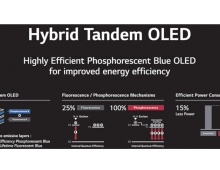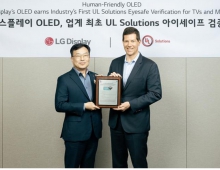
LG Display to Invest Additional $2.6 billion into Gen 10.5 OLED Production Line in Paju
LG Display will invest additional KRW 3 trillion into Gen 10.5 (2,940mm X 3,370mm) OLED production line at its P10 plant in Paju, Korea.
With this investment, the company is stepping up its efforts to shift its OLED-focused business structure and to advance the OLED era.
LG Display decided to expand the company’s large-sized OLED production infrastructure as the demand for OLED has grown sharply. The company will mainly produce 65-inch and above supersized OLED panels from the Gen 10.5 production line. It will start producing 30,000 sheets per month from the first half of 2022. An additional 15,000 sheets per month will be produced from the first half of 2023.
LG Display started investing KRW 1.84 trillion to build its new P10 plant and some of its facilities in November 2015. In July 2017, it decided to make an up-front investment of another KRW 2.8 trillion mostly into OLED substrate production for a monthly OLED production capacity of 30,000 sheets. Today, the company has decided to invest another KRW 3 trillion, which will mainly be used to build an OLED evaporation facility for the 30,000 sheets as well as another facility to produce an additional 15,000 sheets per month.
LG Display expects to solidify its competitiveness in the large TV market once it completes its Gen 10.5 OLED production facility. In addition, it will continue to lead the existing TV market with differentiated OLED products, such as wallpaper OLED, Crystal Sound OLED and rollable OLED, and will create a new market by expanding applications that can use OLED panels.

LG Display will operate its Gen 10.5 OLED production line along with its existing OLED production lines to improve efficiency and maximize profitability. Its Gen 8.5 (2,200mm X 2,500mm) plants in Paju, Korea and in Guangzhou, China, and the to-be-completed Gen 10.5 plant in Paju, will each produce large-sized OLED panels that are optimized for their corresponding regions and fab generations in terms of size and product category. Most notably, the company will use the MMG (Multi Model on a Glass) method to improve glass efficiency and expand supply, which in turn will maximize profitability.
Based on the increased production and cost efficiency that its Gen 10.5 OLED production line will bring about, LG Display sayd it will find new applications and markets for OLED while also expanding the existing OLED TV market.
According to IHS Markit, 2.9 million OLED TVs were sold globally last year. The total sales volume is forecast to reach 3.8 million this year and 10 million by 2022.
Meanwhile, LG Display said it posted 5.35 trillion won in sales in the second quarter of 2019, decreased by 5% from the second quarter of 2018 and decreased by 9% from the first quarter of 2019. The company also reported an operating loss of 368.7 billion won in the second quarter of this year.
LG Display said sales decreased due to macroeconomic concerns and uncertainty such as the trade war between the U.S. and China, which turned set makers, as well as retailers, conservative, creating weaker-than-expected demand in panels and a consequent decline in panel prices.
The company's operating loss in the second quarter was attributed to one-off expenses incurred to strengthen its capabilities in the mobile sector business and to "prepare for the future."
Panels for TVs accounted for 41% of the revenue in the second quarter of 2019, up 5% point from 36% thanks to the sales portion increase in OLED TV panels. Mobile devices accounted for 19%, tablets and notebook PCs for 22%, and desktop monitors for 18%, respectively.
“We expect a positive outlook for the large-sized OLED business in the third quarter with the Guangzhou OLED fab starting production, which will almost double our OLED production capacity,” said Dong-hee Suh, CFO and Senior Vice President of LG Display. “In addition, a new POLED fab for mobile devices in Paju, Korea will also start mass production soon, increasing the capacity and sales of mobile POLED panels to take that business to the next level. In the business of automotive panels, the company will expand its automotive business area and launch new POLED based automotive products in the latter half of this year for the first time, solidifying LG Display’s market position.”
He added, “LG Display is the only company that has a wide OLED portfolio from small-sized wearables to large-sized TVs. Through stabilized small- and large-sized OLED production starting in the second half of the year, the company will increase its opportunities and change its business structure accordingly. As the large-scale investment into OLED that began in 2017 will come to an end this year, the company will respond faster and more flexibly to unexpected external variables in order to create meaningful performance starting from next year.”





















